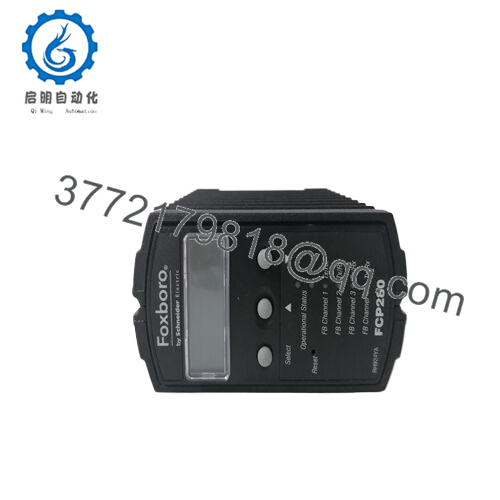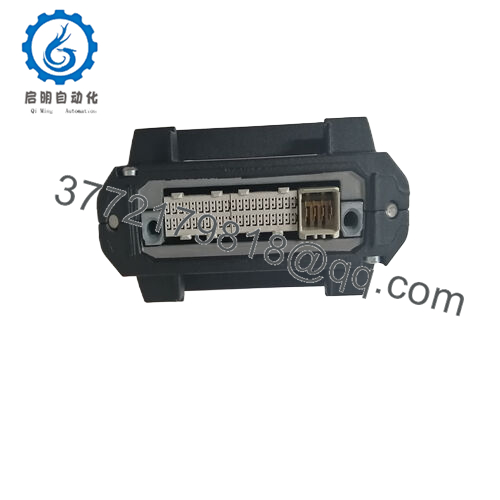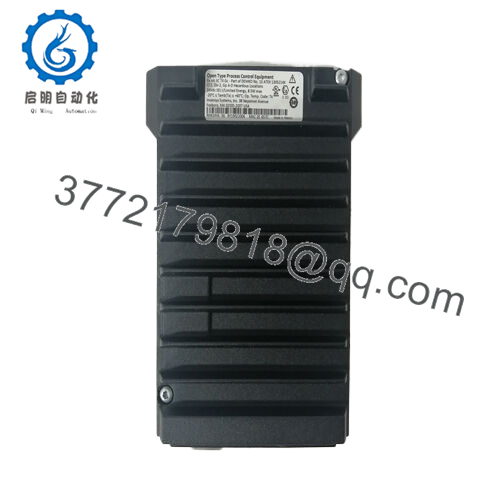Description
In industrial automation, where even momentary lapses in control logic can spiral into widespread process disruptions or safety risks, engineers often battle the limitations of centralized controllers that struggle with distributed I/O demands, leading to latency issues, scalability bottlenecks, and vulnerability to single failures in expansive networks. The FOXBORO FCP280 RH924YA counters this as a field-mounted control processor, delivering decentralized, fault-tolerant execution of regulatory and sequential strategies right at the edge of your operations, ensuring high-reliability process control without the drag of long-distance signaling. This module becomes indispensable in setups like expanding DCS footprints in oil refineries or hardening controls in water treatment basins, where integrating hundreds of field devices requires robust, on-site decision-making to avert alarms from transient glitches. Think of a continuous polymerization unit in a plastics facility, juggling PID loops for temperature and pressure amid fluctuating feeds—the FOXBORO FCP280 RH924YA processes inputs locally, firing outputs with microsecond precision to stabilize reactions, sidestepping the downtime that rigid architectures might invite from network congestion. By targeting aims like modular expansion and alarm resilience, it lets teams build resilient I/O architectures that adapt to growth, minimizing the engineering toil of retrofitting monolithic systems. For practitioners in industrial automation, the FOXBORO FCP280 RH924YA excels during migrations to fault-tolerant designs, where its self-booting capability keeps loops alive sans host intervention, bolstering signal integrity in EMI-heavy zones. It aligns perfectly with goals of uninterrupted data acquisition, enabling predictive diagnostics that catch anomalies before they escalate, all while supporting Ethernet backbones for seamless DCS fusion. In short, this processor reframes edge computing as a strategic asset, empowering you to orchestrate complex flows with confidence rather than constant oversight in volatile process environments.
- FOXBORO FCP280 RH924YA
- FOXBORO FCP280 RH924YA
The FOXBORO FCP280 RH924YA acts as the computational heart of a Foxboro I/A Series subsystem, executing control algorithms on its ARM-based SOC while interfacing with up to 128 FBM modules via the high-speed HDLC fieldbus, all housed in a rugged, field-deployable chassis. Sitting at the intersection of the automation stack—bridging field I/O layers to the Mesh control network—it ingests analog/digital signals from sensors and actuators, crunches them through ladder logic or function block programming, and dispatches commands without relying on remote hosts, ideal for backplane-less distributed architectures. In a typical configuration, it slots into a carrier with redundant power feeds and fiber optic links to the DCS backbone, supporting online upgrades that refresh firmware mid-operation to dodge process halts. Diagnostics flow via an LCD panel showing real-time status, while ECC memory guards against bit flips in high-throughput scans, complementing redundant pairings where a secondary unit shadows the primary for bumpless failover. Protocols like 100 Mbps Ethernet ensure low-latency handoffs to workstations for historian logging or HMI visualization, with no dedicated fieldbus module needed for core ops. Imagine it in a batch blending skid: the FOXBORO FCP280 RH924YA polls flow transmitters over the fieldbus, applies timing sequences for valve sequencing, and flags deviations to the network—all while self-hosting a validated database for standalone resilience. This edge-centric role streamlines I/O orchestration, letting you daisy-chain modules in cabinets far from the control room, and frees bandwidth for advanced analytics rather than basic polling, making it a natural fit for engineers scaling hybrid analog-digital ecosystems without overhauling cabling runs.
| Specification | Details |
|---|---|
| Model Number | FCP280 RH924YA |
| Brand | FOXBORO (Schneider Electric) |
| Type | Field Control Processor Module |
| Input Voltage | 24 V DC |
| Operating Temp Range | -40°C to +70°C |
| Mounting Style | DIN Rail / Panel Mount |
| Dimensions | 200 mm x 150 mm x 100 mm |
| Weight | 2.5 kg |
| Interface/Bus | HDLC Fieldbus / 100 Mbps Ethernet |
| Compliance | CE, RoHS, ISA S71.04 |
| Supported Protocols | Modbus TCP, Ethernet/IP |
| Typical Power Draw | 15 W |
Deploying the FOXBORO FCP280 RH924YA instills a layer of operational autonomy that elevates process control from reactive to anticipatory, as its field-level execution curtails signal propagation delays, yielding tighter loop responses that steady variables like flow or level amid upsets and trimming variance in end products. Designed with industrial grit in mind, it upholds performance fidelity through vibration and thermal flux, which extends the viability of legacy expansions and curtails the frequency of full-system validations, handing back hours to your crew for strategic tweaks over patch jobs.
Fault tolerance baked in reduces the specter of control gaps, with redundant modes that mirror states invisibly, slashing mean time to recovery in scenarios where every second offline erodes margins—pair this with self-diagnostics, and you’ve got a setup that surfaces issues via network alerts, streamlining triage without exhaustive logs. The module’s Ethernet-native connectivity eases fusion into broader SCADA fabrics, lightening integration burdens during brownfield projects and fostering a modular ethos where adding I/O feels incremental, not invasive.
What emerges is a fortified automation core: the FOXBORO FCP280 RH924YA not only safeguards uptime but amplifies it, channeling consistent throughput that compounds into measurable ROI through fewer incidents and sharper asset utilization.
In offshore gas gathering platforms, the FOXBORO FCP280 RH924YA anchors compressor sequencing in I/A Series nodes, executing logic for pressure safeguards amid saline gales and seismic jolts, delivering critical system uptime for export flows in remote, high-stakes process control environments.
Cement kilns harness it for kiln drive coordination, where the processor tallies speed feedbacks and ignition timings over fieldbus links, thriving in dusty, 1200°C vicinities to enforce precise thermal profiles and sustain 24/7 clinker production with unyielding reliability.
Pulp mills embed the FOXBORO FCP280 RH924YA in digester controls, managing batch charges and pH corrections via distributed FBMs, excelling in steamy, fiber-laden atmospheres to optimize yield cycles and prevent overcooking in fast-paced, continuous digestion ops.
FCP270 P0917YZ – Predecessor module for legacy I/A Series with reduced FBM capacity in space-limited retrofits.
FCP280 RH924YB – Enhanced variant with expanded memory for data-intensive historian buffering.
FBM230 P0926GU – Companion field device manager for HART integration in smart transmitter arrays.
FCP360 – Next-gen processor for higher-speed Ethernet in modern Foxboro Evo upgrades.
FBM201 P0916AA – Eight-channel analog input add-on for sensor expansion on FCP280 buses.
P0914XX – Power supply module for redundant 24 V DC feeds to FCP chassis.
FBM242 – Discrete output expander for actuator clusters in sequential-heavy applications.
FBM207 P0916JS – Sixteen discrete input for status polling in alarm-rich monitoring setups.
Before commissioning the FOXBORO FCP280 RH924YA, audit your fieldbus topology against the max 128 FBM limit—mixing 100/200 series is fine up to 64 of the former—to forestall overloads, and verify Ethernet cabling specs for 100 Mbps integrity, as cat5e minima curb packet loss. Slot it into the carrier with firmware synced to the host station, powering up in phases to monitor LCD boot sequences for anomalies, and baseline ambient temps below 50°C to buffer heat from adjacent modules.
Sustained vigilance calls for monthly scans of the status display for role shifts or ECC flags, particularly in humid enclosures where condensation might etch connectors—a dry nitrogen purge quarterly mitigates that. Yearly, during non-peak windows, execute an OLUG test to validate image swaps, and probe fieldbus traffic with the I/A diagnostics suite for latency spikes that signal cable wear. If alarms cluster on specific FBMs, trace via event logs to isolate, swapping fuses or reseating links methodically. This grounded routine, leaning on built-in tools over specialized gear, preserves the processor’s edge without undue disruption.




 WhatsApp: +86 16626708626
WhatsApp: +86 16626708626 Email:
Email:  Phone: +86 16626708626
Phone: +86 16626708626


